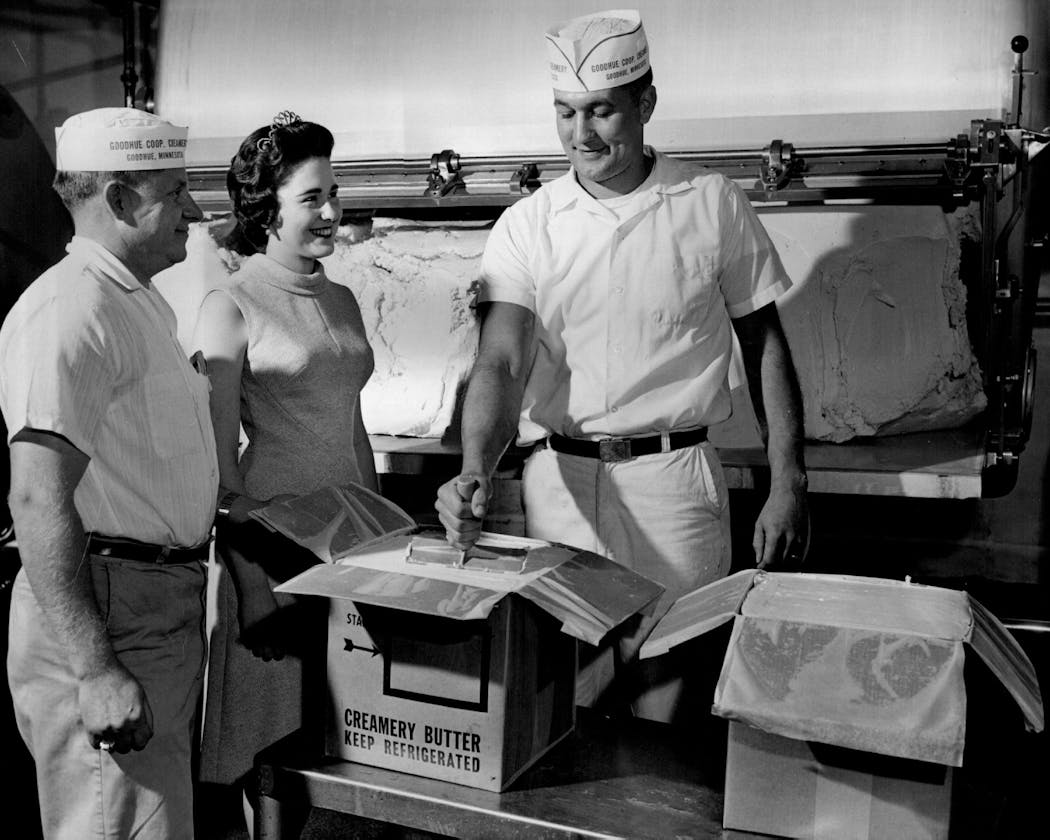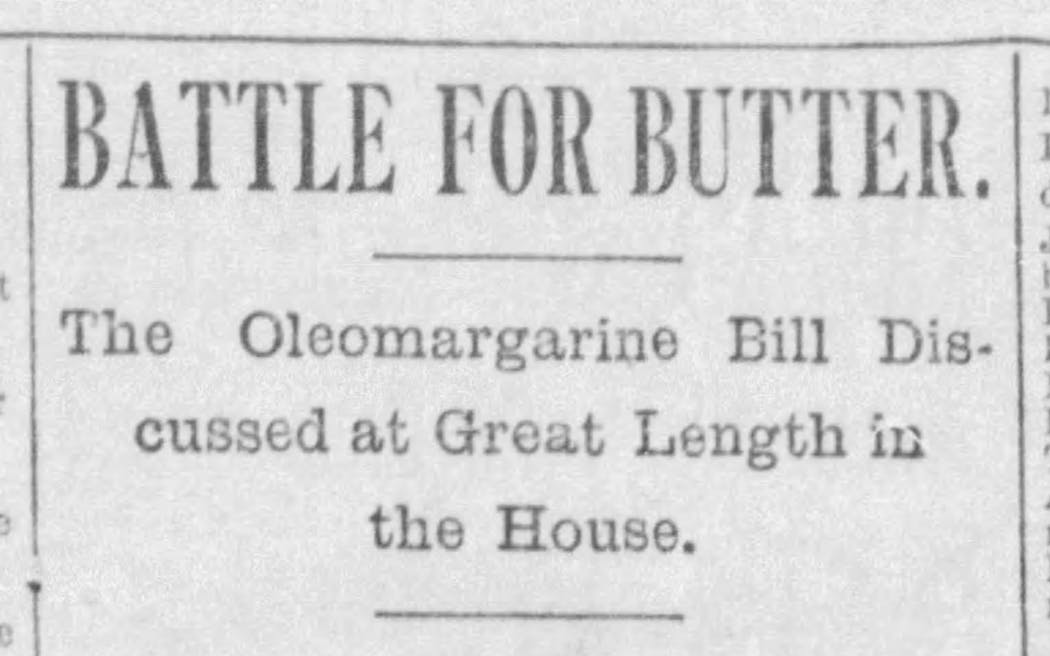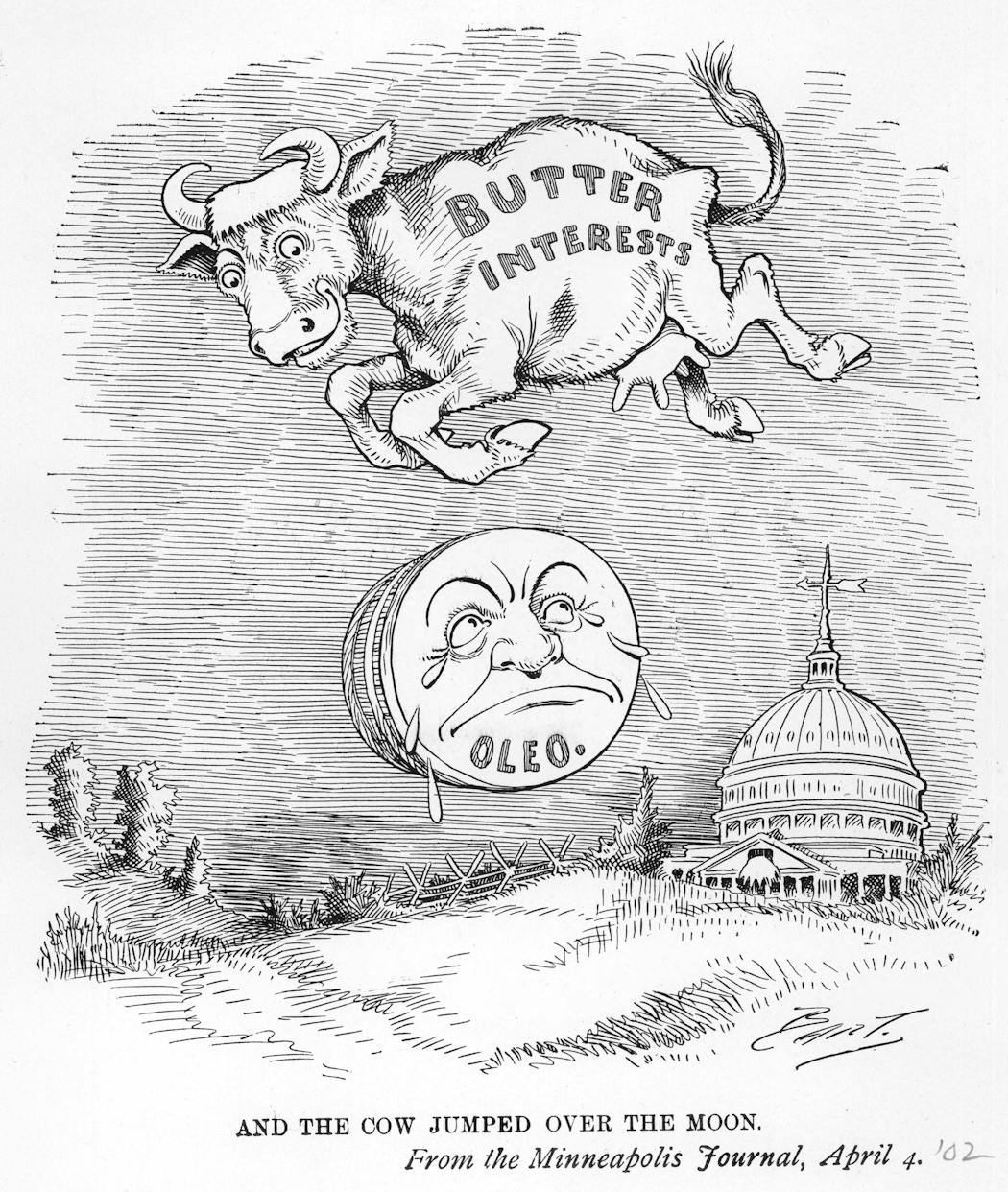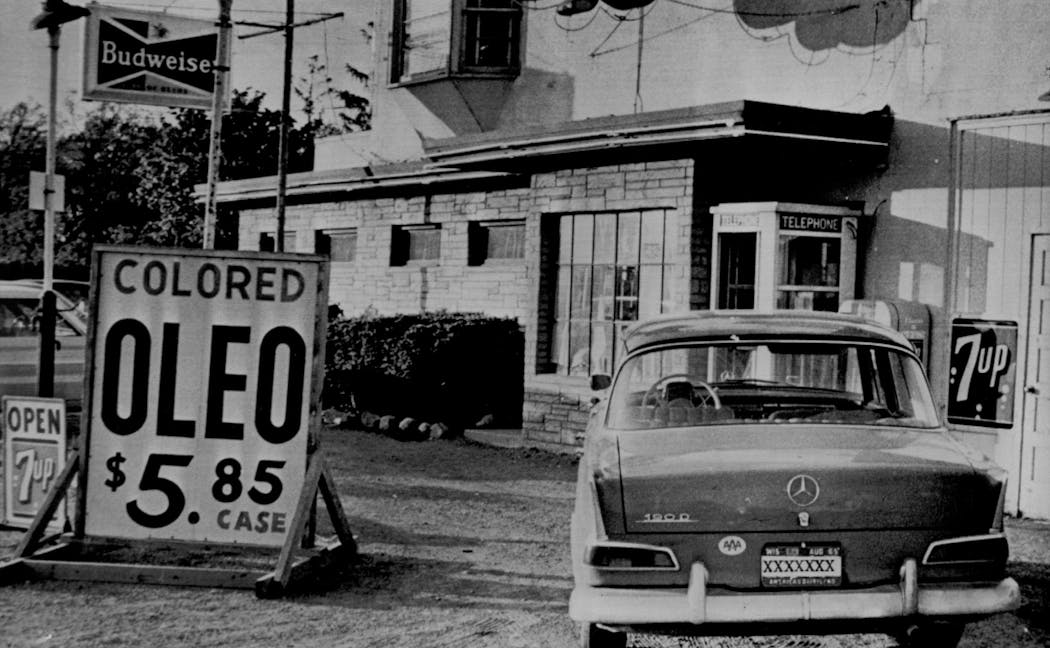Why did Minnesota once require margarine to be dyed pink?
Listen and subscribe to our podcast: Via Apple Podcasts | Spotify | Stitcher
A century ago, Minnesota produced more butter than any other state, a legacy that lives on in Land O' Lakes and our prized State Fair butter sculptures. But our dairy dominance also fueled the state's involvement in a successful, nationwide effort to quash the fatty spread's archrival – margarine.
Initially known as oleomargarine, the cheap butter alternative rapidly grew in popularity after it arrived in the United States from Europe following the Civil War. And it just as quickly found enemies among the politically powerful dairy lobby, which used regulations and taxes to undercut margarine's success for more than 70 years.
"It is very evident that laws with severe penalties must be enacted in order to crush out this counterfeiting of butter," the Iowa-based American Dairyman newspaper proclaimed in 1881.
Car service owner Chey Eisenman learned about the "margarine wars" from a passenger who was a history professor, after asking for a fun fact about Minnesota history.
"She told me about how margarine had to be dyed pink as part of the margarine wars — I had no idea," said Eisenman, a former dairy princess whose father was a Fillmore County dairy farmer. When Eisenman tweeted about the subject in March, David Loos replied that it should be a topic for Curious Minnesota, the Star Tribune's reader-powered reporting project.
The battle against margarine was a big deal in Minnesota, which became the nation's leading butter producer in 1920.
The Minnesota Legislature was an early leader in the effort to outlaw oleo, joined by other dairy states and even Congress in the late 19th and early 20th centuries. At one point, Minnesota did in fact require the "bogus butter" to be dyed pink to protect its dairy farms and creameries.
Minnesota bans margarine
A French chemist invented oleomargarine, a mix of animal fat and vegetable oil, to cheaply feed the armies of Napoleon III in the 1860s. The spread quickly jumped the Atlantic to the rapidly urbanizing United States, joining a host of new modern conveniences.
In 1873, the first U.S. patent was granted for oleomargarine — shortened later to oleo. The industry took off.
Minnesota's dairy industry was growing rapidly during this period, so the state jumped into the fight against this new product.
In 1885, Minnesota became one of the first states to ban the production and sale of what Gov. Lucius Hubbard termed "oleomargarine and its kindred abominations," according to a Minnesota Historical Society accounting of the margarine wars.
Then in 1886, the U.S. Congress passed a two-cent-per-pound margarine tax (60 cents today) and exorbitant licensing fees in what was a significant expansion of federal regulatory powers.
Margarine "yielded high profits but cost very little, making it popular among both industrialists and the millions of consumers who couldn't afford real butter during a lingering economic recession," according to a U.S. House of Representatives history of the Oleomargarine Act. "Dairy interests, however, saw margarine as a threat and appealed to Congress to regulate it with a prohibitive tax."
"I would make the tax so high that the operation of the law would utterly destroy the manufacture of all counterfeit butter and cheese," Wisconsin Rep. William Price said at the time.
In Minnesota, the new federal regulation meant oleomargarine could no longer be banned outright, according to the Minnesota Historical Society. So legislators found other ways to strangle the industry with regulation — including an 1891 law that required oleomargarine be dyed pink before it could be sold to consumers.
"All oleomargarine contains coloring matter. Let the color be pink instead of yellow," the Minneapolis Tribune opined in 1887. "This simple device would effectively protect the public from deception, and the buttermakers would have no further ground to complain of fraudulent competition with their product."
This law "effectively halted all sales of oleo in the state in the 1890s," Dave Kenney wrote in an article for the Minnesota Historical Society. The Minnesota Supreme Court upheld the state's pink law, but the U.S. Supreme Court ruled in 1898 that these laws around the country were unconstitutional.
Federal justices wrote in their decision the policy "naturally excites a prejudice and strengthens a repugnance up to the point of an absolute refusal to purchase the product at any price."
Indeed, margarine struggled to grow as the dairy industry successfully painted it as a chemical copycat that undercut America's agrarian ideal. But the pink law repeal gave it a new opening.
'A healthier alternative'
Dairy backers remained determined to keep the butter substitute from looking like butter. Industry interests often claimed margarine was being passed off as authentic butter in stores and restaurants.
While dairy-state legislators couldn't require it be an artificial pink, the color of the spread remained a central strategy to squash sales. In 1902, a new nationwide oleomargarine law levied a 10-cent tax (more than $3.50 today) on every pound of yellow-colored margarine.
Many dairy states also added their own layers of legislation that effectively outlawed yellow margarine so it could not pose as real butter.
These efforts took several tries to pass judicial scrutiny in Minnesota. But in 1913, a law passed that stated oleomargarine must be 55% white.
To get around these laws, margarine makers started to add packets of yellow dye that could be massaged into their product to get that buttery-yellow color. And despite continued negative publicity from the dairy industry — and terms like "bogus butter" often used by sympathetic news outlets — margarine sales started climbing in the 1930s.
So in 1933, during the Great Depression, Minnesota legislators imposed a new 10-cent tax on margarine, which together with the federal tax brought margarine prices closer to what consumers were paying for butter at the time.
As the nation rationed food during World War II and the culture war over margarine softened by necessity, restrictive laws and taxes started to fall away. National margarine consumption overtook butter in the 1950s, U.S. Department of Agriculture data shows.
"At the time, margarine was touted as a healthier alternative to butter because it contained less saturated fat," the USDA recounted.
The national 10-cent tax on yellow margarine was repealed in 1950.
Butter reclaims its throne
Minnesota was one of the last states to repeal its margarine-color law — and it did so with support from the state Farm Bureau, whose soybean growers were by now providing oil for margarine.
"A lot of people now go to Iowa to buy colored oleo," a Farm Bureau delegate told the Minneapolis Tribune in 1962. "And by keeping the ban, we just encourage this bootlegging."
Minnesota lifted the ban on yellow margarine the next year. Wisconsin was the last state to repeal a margarine-color law in 1967.
A review of the issue in a 1982 edition of the journal Social Problems found it was the transition from a rural nation to a largely urban one that colored the margarine debate: "The margarine case was influenced by almost everything but the chemical composition or nutritional properties of the product."
Butter would eventually prevail over margarine once more, and this time it did not require protectionist policies.
Around 2005, the health hazards of trans fats — a byproduct of hydrogenated oils then commonly used to stabilize margarine — were widely publicized. A better understanding of dietary fat also took some stigma off butter after suffering from decades of low-fat diet trends.
As a result, butter consumption climbed above margarine for the first time since the Eisenhower administration, according to federal data.
Today, on a per-capita basis, butter consumption is a third what it was during the height of the oleomargarine wars in the early 20th Century. Minnesota, while still a major dairy state with the nation's seventh largest dairy herd, has long lost its lead in butter production.
A partial ban on trans fats has given margarine a renewed healthy shine. Margarine brands these days are unlikely to include animal fat, as the oleo makers of old long did. Country Crock even has a new angle for the modern revival of this culture war: "Plant Butter."
If you'd like to submit a Curious Minnesota question, fill out the form below:
Read more Curious Minnesota stories:
Why are Honeycrisp apples still so expensive?
The Jolly Green Giant has moved on from Minnesota. So who is maintaining his iconic billboard?
How do food scraps get recycled in Minn. — and how good are we at it?
Corn dog vs Pronto Pup: Why are people so loyal to one or the other?
Why don't farms water their crops at night?
Why is Minnesota the last state with 3.2 beer?







